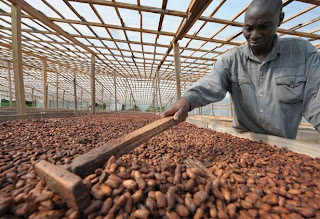Can science make chocolate taste (even) better? - The Week
Scientists have cracked the DNA code of the cacao plant. Will our future selves be tempted by yet yummier sweets?
Collected from: Can science make chocolate taste (even) better? - The Week
First rice, then wheat – now cocoa genome unravelled - Science, News - The Independent
Scientists have sequenced the genetic code of the cocoa tree, which they say could triple the yield of the disease-prone crop and transform the lives of millions of poor farmers in Africa and around the developing world who rely on it for their livelihood.
Collected from: First rice, then wheat – now cocoa genome unravelled - Science, News - The Independent
The Science of Chocolate: Studying a Cacao Tree’s Genome - TIME NewsFeed
As the CBC notes, approximately 2.7 million tons of cocoa is produced annually across the world. But farmers subsequently lose $700 to $800 million from the aftereffects of damages to cacao trees. By studying the genetic backbone of the plants, researchers believe they can produce trees with a higher immunity to disease, thereby improving the cacao pods' overall yield.
A Taste Of The Chocolate Genome - Science News
Competing teams announce impending completion of cacao DNA sequence
Two independent teams have completed drafts of the DNA sequence of the cacao tree, the source of chocolate, scientists announced September 15. Both efforts will eventually help breed plants that resist disease yet still bear superior beans, the researchers claim.[...]
A team led by candy maker Mars, Inc., the U.S. Department of Agriculture and IBM announced the unveiling of a preliminary genome of the cacao tree, Theobroma cacao, that’s available to the research community at www.cacaogenomedb.org.[...]
The second team has a very detailed draft, says plant molecular biologist Mark Guiltinan of Pennsylvania State University in University Park. He and his collaborators have discovered hundreds of genes associated with disease resistance and with high-quality pods.
Collected from: A Taste Of The Chocolate Genome - Science News
Penn State Live - Analysis of the chocolate genome could lead to improvement
University Park, Pa. -- The sequencing and analysis of the genome for the Criollo variety of the cacao tree, generally considered to produce the world's finest chocolate, was completed by an international team led by Claire Lanaud of CIRAD, France, with Mark Guiltinan of Penn State, and included scientists from 18 other institutions.
"The large amount of information generated by this project dramatically changes the status of this tropical plant and its potential interest for the scientific community," said Guiltinan, professor of plant molecular biology, Penn State.
Mars.com -MARS, USDA-ARS, And IBM Unveil Preliminary Cacao Genome Sequence Three Years Ahead Of Schedule
Landmark Research Effort Will Make Findings Publicly Available for Common Good
Results to Benefit 6.5 Million Farmers Worldwide and Sustain World’s Cocoa Supply
Results to Benefit 6.5 Million Farmers Worldwide and Sustain World’s Cocoa Supply
McLean, VA –Today, Mars, Incorporated, the U.S. Department of Agriculture-Agricultural Research Service (USDA-ARS), and IBM released the preliminary findings of their breakthrough cacao genome sequence and made it available in the public domain. This is the result of a joint research endeavor to improve the cocoa growing process and represents a successful private/public partnership for the benefit of the world’s cocoa farmers, and a more sustainable world cocoa supply.
The preliminary sequencing of the cacao genome is a promising first step in advancing farmers’ ability to plant more robust, higher yielding and drought and disease-resistant trees. The results of the research will be made available to the public with permanent access via the Cacao Genome Database (www.cacaogenomedb.org) to ensure that the data remains perpetually open without patent, as well as to allow scientists to begin applying the findings immediately to crop cultivation efforts.
Collected from: Mars.com -MARS, USDA-ARS, And IBM Unveil Preliminary Cacao Genome Sequence Three Years Ahead Of Schedule
- Sources
- Can science make chocolate taste (even) better? - The Week
- First rice, then wheat – now cocoa genome unravelled - Science, News - The Independent
- The Science of Chocolate: Studying a Cacao Tree’s Genome - TIME NewsFeed
- A Taste Of The Chocolate Genome - Science News
- Penn State Live - Analysis of the chocolate genome could lead to improvement
- Mars.com -MARS, USDA-ARS, And IBM Unveil Preliminary Cacao Genome Sequence Three Years Ahead Of Schedule
- Related
- M. Guiltinan Lab - Plant Biotechnology and Molecular Biology
- M. Guiltinan - Plant Biotechnology and Molecular Biology
- Sweet scientific discovery in the world of chocolate - CNN.com
- Scientists Unlock Cocoa Genome, Release to Public Domain | Reuters
- Mars.com - Home
- M. Guiltinan - Plant Biotechnology and Molecular Biology
- Welcome to the Cacao Genome Project | Cacao Genome Database
- A Taste of the Chocolate Genome - US News and World Report


